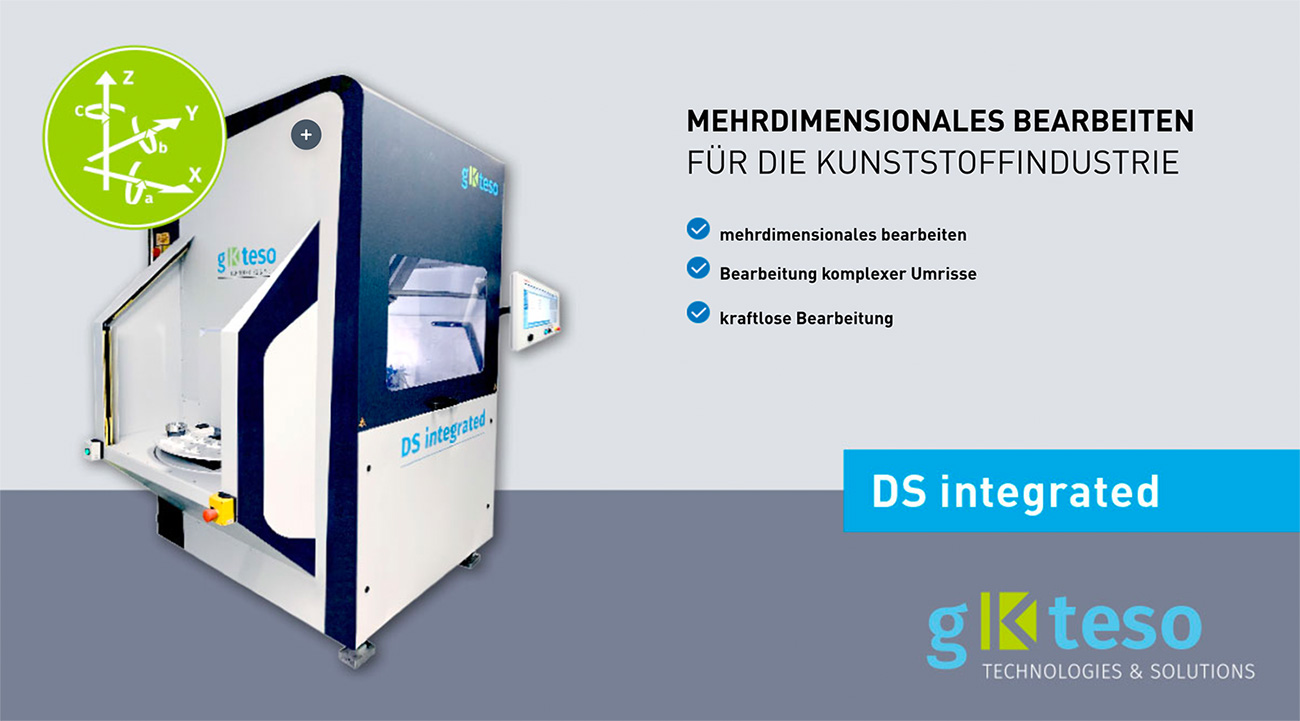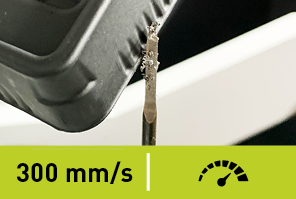Machines for plastic parts
- Precise, fast processing
- Machining of different materials
- even for hard-to-reach places
Machines for plastic parts
Precise reworking and deburring of plastic components
- Precise, fast processing
- Machining of different materials
- even for hard-to-reach places
Automated Machining Centers for Plastic Components Processing
Finishing Plastic Components with gKteso
The plastics industry thrives on the production of molded components, semi-finished products, fibers or films made of plastics. For the processing of the different plastics, forming, shaping and joining processes are of particular importance. In most cases, this is followed by the need to finish the manufactured parts.
gKteso provides efficient solutions with its technology spectrum, especially with its finishing machines for the processing of plastic parts. The high-performance automated and multi-axis systems process and deburr even complex components.
- Milling
- Drilling
- Thread cutting
- Deburring
- Grinding
- Marking
- Checking
- Milling
- Drilling
- Thread cutting
- Deburring
- Grinding
- Marking
- Checking
High throughput during finishing of plastic components
- Automated systems
- Precise, fast and multi-axis
- High throughput
High Throughput During Finishing of Plastic Components
Do you have questions about the technology solutions from gKteso for the plastics industry for machining plastic parts? Then call us or write to us.
+49 8234 966 38 41
- 28 years of experience
- Specialists for the machining of complex workpieces
- Sophisticated modular system
Do you want to know more about plastic parts machining with machines from gKteso?
We look forward to receiving your inquiry!
Glass fiber reinforced
plastics (GRP)
Machining Glass Fiber Reinforced Plastic (GRP) Components in Series Production
The Finishing of Complex, Multi-Dimensional Workpieces
Glass fiber reinforced plastic (GRP) is popular as a comparatively inexpensive and at the same time high-quality material mix of plastic and glass fibers. Glass fiber reinforced plastic has a relatively high modulus of elasticity. The corrosion behavior of glass fiber reinforced plastics is very good, even in harsh environments. GRP is therefore a perfect material for many components. Due to its good electrical insulation effect, it is also often used in electrical engineering.
Even complicated constructions made of GRP can be easily machined in three dimensions by gKteso.
The flexibility of gKteso’s systems is in demand when complex contours or hard-to-reach areas require gentle machining.
Thermoformable
Plastics
Finish Thermoformable Plastics with Finishing from gKteso
Process-Reliable Reworking of Workpieces Made of Different Plastics
Thermoforming of thermoplastics can be an alternative to injection molding, especially for medium series, because the tool costs are lower. Plastics used to substitute metals are continuing to gain ground, as they reduce the weight and cost of end products. Plastics are therefore used primarily in the automotive sector. After thermoforming, the plastic parts are often punched. In order to remove sharp-edged burrs, round off edges or produce clean flat surfaces, efficient finishing in reproducible quality is essential.
With equipment from gKteso, thermoformable plastics achieve their final properties for a wide range of applications. Depending on the requirements, various tasks such as drilling, milling, thread cutting, grinding or marking & testing can be handled in just one pass, even for complex workpieces. Finishing is carried out in a particularly time-saving but at the same time highly precise manner.
Composite
Plastics
COMPOSITE PLASTICS
Composite plastics play an important role in aerospace, but also in the automotive sector, because they can be used to create particularly lightweight yet stable designs. In terms of weight, composite plastics perform even better than aluminum and are around 30 percent lighter.
Fiber-reinforced plastics, or composite plastics for short, consist of reinforcing fibers surrounded by a matrix of plastic. This combination of fiber and matrix material creates a new construction material with specific properties – above all high rigidity and strength. Depending on the composition, the variability of the fibers and matrix materials enables customized materials. Composite plastics are mainly used to produce flat structures for lightweight applications.
Multi-dimensional machining
for the plastics industry
- Multi-dimensional machining
-
Machining of complex outlines
- Powerless machining


Milling
Plastic parts machining can start as early as milling: Whether flat surfaces or demanding 3D contours – produce precision milled parts quickly and reliably with systems from gKteso.

Drill & Cut Threads
Precise drilling in the shortest possible time: Parts made of plastic become mountable through precise drilling. Subsequent drilling and / or thread cutting ensures a wide range of variants.

Deburring
Biaxial grinding or deburring with the blade? Depending on the material used and the component geometry, various deburring processes are possible.

Grinding
Improved dimensions or optimized surface technology: Grinding brings plastic into shape and prepares components for further work steps.

Marking & Checking
Laser scanners and 3D probes inspect plastic components section by section or completely. Final markers convey important information.
Milling plastics
with gKteso
Milling
Precise milling of contours or cutouts
Prefabricated plastic parts can be used in a variety of ways: as gears, guides, drive components, housings or mountings. To ensure that the components fit perfectly, reworking of the plastics is particularly important. During milling, problematic contours are removed or functional surfaces are milled flat. But separating edges can also be precisely re-milled.
- Milling true to size
- Defined precision
- Mill complex 3D contours
Drilling plastics
with gKteso
Drill & cut threads
Precise drilling and thread cutting
Ensuring variant diversity and optimizing plastic parts
Thermoformable plastics or injection molded parts are used in automotive manufacturing, the electrical industry or as technical plastic components. Depending on their intended use, plastic components can be used as cladding, bearings or supports, for example. In the product, the parts must be fixed or provide a receptacle.
- Drill blind holes
- Drill out conical holes
- Drill variants
Precisely fitting holes are therefore important to enable connections. If the holes are subsequently incorporated, this ensures a wide range of variants: Various drill holes enable reliable mounting of the plastic part even in different environments.
Deburring plastics
with gKteso
Deburring
Clean deburring of plastic parts
Different knives and blades allow clean edges
During the production of plastic parts, sharp and problematic edges occur. These are removed during deburring. Depending on the plastic used, different techniques are necessary, such as grinding with biaxial grinders or the use of deburring blades.
- Deburr edges
- Deburr curves
- Deburr flexible transitions
In order to adequately deburr plastic parts, the blades must be guided with particular precision. With suitable blades, plastics of different hardness and components with different shapes can be cleanly deburred on straight edges, but also curves or surfaces.
Grinding plastics
with gKteso
Grinding
Regrinding and sharpening
Plastic machining often requires shape corrections or preparation for coatings
In order for components made of plastic to conform to the specified dimensions, shape corrections may be necessary during finishing. Regrinding and sharpening can significantly improve the shape fidelity. Particularly high-quality contours are required for laminated parts, for example. Here, multiple layers of fiberglass mats and resins are bonded to produce the component.

Grinding subsequently ensures exact dimensional accuracy or preparation for subsequent machining steps. Whether bonding, printing, painting or a coating process – the result will only be perfect if a flawless surface is available.
- Optimize shapes
- Reproducible shapes
- Optical improvements
Mark plastics
with gKteso
Mark and check
Improve quality through testing and component identification
Laser scanner and 3D probe reliably check the fit
To improve the quality of plastic components, careful final inspection is particularly important. Laser scanners or 3D probes inspect either the relevant contour sections of the components or the entire part. After successful inspection, the part can be finally marked, for example with a part number, the date or an ident code.
Depending on the requirements for durability and legibility, this marking is printed on, applied by laser or engraved – a separate system for marking is not necessary, which saves space in production and handling times.
- Improve quality
- Assign parts reliably
- Document production











